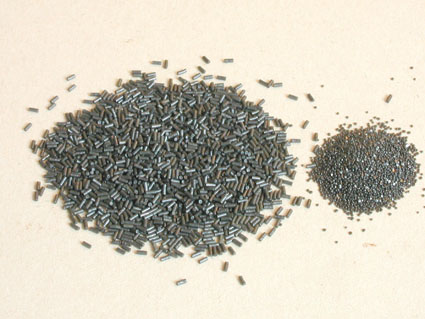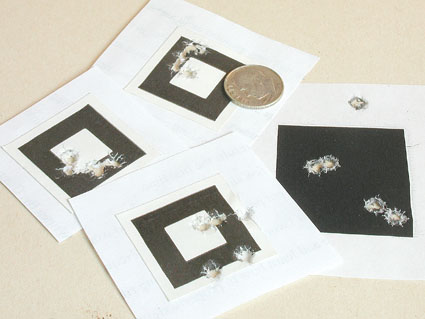Summer through late fall is prairie dog and ground squirrel time. When you get on site, you want to set up your bench and shoot dogs, not spend a lot of time having to clean and re-clean your bore so you can make long shots. The amount of time you have to spend cleaning depends a lot on your choice of rifle and the load you pick.
The majority of rifles are easy to get along with. On the other hand, I’ve concluded that some varmint rifle’s personalities border on schizophrenia.
Why is it that one rifle is capable of firing bucketfuls of cartridges without needing a thorough cleaning, and still maintain “minute of gopher accuracy” clear across the back forty, while another demands a good scrubbing every 20 rounds or so to produce the same results? This “pickiness” can become frustrating in short order, especially if you happen to be sitting on a comfortable stand overlooking the main street of a busy prairie dog town.
I’ve often wondered what causes this nagging malady, but never spent much time trying to analyze it. So, I donned my battered thinking cap and tried to figure out how we can shoot more and clean less.
Consider the Ammo
Some varmint cartridges, like the .22-250, .220 Swift, and the .25-06 have a reputation for fouling worse than the .223 Remington or .22 Hornet. We all accept this, and for the most part, work within their limitations. I’ve always despised limitations, and thanks to the plethora of quality reloading components on the market today it is possible to build a handload that will allow you to shoot more and clean less.
Begin with propellants. Generally, single-based extruded powders burn much cleaner, are more consistent than double-based extruded propellants, and are clearly cleaner burning than ball powders. Let’s say you’re currently using a healthy dose of BLC-2 and a lightweight bullet in your pet varmint rifle. My guess is the load is exceptionally accurate but is messier  than a wet and muddy bird dog.
than a wet and muddy bird dog.
The best way to correct this problem would be to try a single-based extruded powder on the faster side of the burn rate chart. You’ll be using less powder to achieve similar velocity and the load will generate less heat, less gas escaping the muzzle, and less fouling. The result will be more shooting and less cleaning. That can make a difference on a dog town.
Aside from propellants, your bullet choice is the next determining factor in how much you can shoot before accuracy falls off and you need to clean. Removing copper fouling is no fun. It’s especially annoying trying to remove it in the field, so choose your bullets wisely.
As a rule, the softer the projectile, the more fouling you’ll encounter. Sticking with a standard construction bullet will produce less mess than a monolithic or solid copper bullet. Another way to reduce copper fouling is to use a more moderate velocity bullet or something closer to “standard weight” for your cartridge. Simply slowing them down can substantially reduce the amount of copper shed on the trip down bore. A hot-moving 40-grain slug will foul considerably more than a 55-grain bullet. Often the heavier number will deliver more downrange energy with less drift. The only tradeoff would likely be a slightly higher trajectory.
Using single-based extruded propellants and standard weight, stouter constructed bullets in your varmint rifles will almost certainly allow you to shoot more and clean less. But what if your particular rifle doesn’t like these projectiles and clearly hates single-based extruded powders? (Some varmint rifles are schizophrenic, remember?)
 You may want to check the condition of your rifle’s bore. Most often, if a custom barrel is mounted to your action you can be assured the bore has been polished and any roughness has been smoothed out. On the other hand, factory barrels from our major manufacturers are almost always in need of a little polishing to bring them up to snuff. Fortunately, this is an easy job even for an amateur.
You may want to check the condition of your rifle’s bore. Most often, if a custom barrel is mounted to your action you can be assured the bore has been polished and any roughness has been smoothed out. On the other hand, factory barrels from our major manufacturers are almost always in need of a little polishing to bring them up to snuff. Fortunately, this is an easy job even for an amateur.
Midway, Brownells, and other shooting supply houses offer bore polishing compounds that will smooth out any roughness with just a few passes through the barrel. They work well.
My pet varmint rig, a T/C Encore chambered in .223 Remington, left the factory with a barrel that was nothing short of a copper magnet. It was accurate, averaging well under one inch at one hundred yards for the first five groups. After that, the group size went out the window. At home, I cleaned the gun thoroughly, then spent the next 30 minutes or so polishing the bore and removing any roughness. The next range visit produced noticeable results. The handgun wasn’t a bit more precise, but I was able to fire 21 five-shot groups, instead of just five, before accuracy began to deteriorate. You may want to treat your bore to a “facial” before giving up on it.
No serious shooter would rather waste their time cleaning rifles than burning powder. By choosing components wisely and easing off the redline loads; you will be able to shoot more and clean less.






